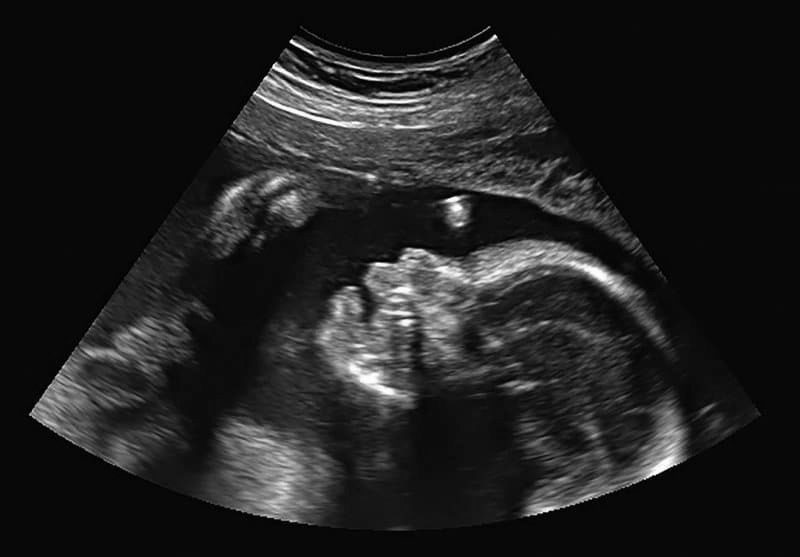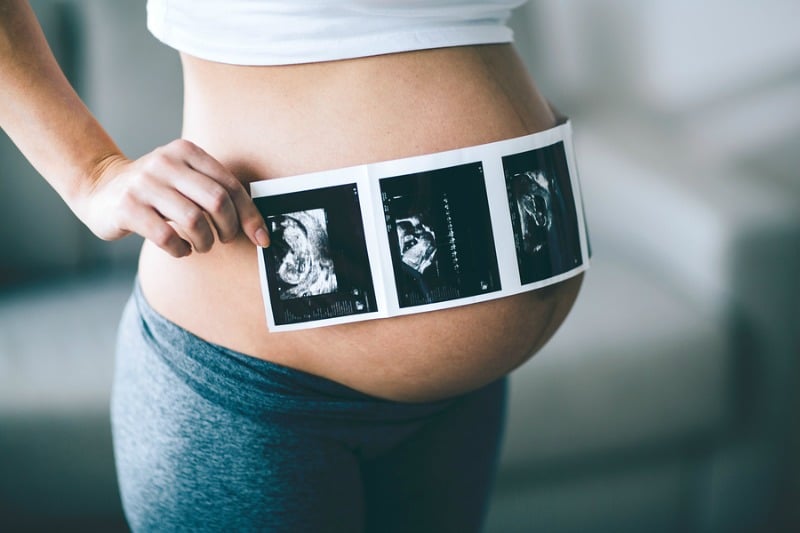Two pink strains. I bear in mind the place I used to be standing the primary time I noticed them, and the way I instantly began wanting ahead to my first ultrasound. I needed to know the whole lot was okay and join with this little being that was going to develop to the dimensions of a watermelon and . . . nicely, let’s simply say that as my practice of thought continued alongside these strains I fully forgot concerning the ultrasound for awhile.
After I did lastly point out it to a buddy, she gently urged that I’d wish to analysis somewhat extra earlier than getting one and not using a clear medical must. I did, and what I discovered shocked me. Right here’s why:
- Routine prenatal ultrasounds haven’t been proven to enhance outcomes for moms or infants. (1) (2) (3) (4)
- No main epidemiological research have been performed on the protection of prenatal ultrasound throughout the U.S. in over 25 years.
Earlier than we go any additional, know this: I’m not in opposition to the usage of prenatal ultrasounds and suppose there are occasions when they’re extremely priceless. With that mentioned, each mama needs to be totally knowledgeable concerning the potential dangers and advantages of getting one, or two, or six based mostly on her distinctive state of affairs. That’s why on this put up we’ll cowl:
-
- What peer-reviewed analysis says concerning the security of ultrasound
- The impact of routine ultrasounds on start outcomes
- What situations ultrasounds can display for (and various take a look at choices when obtainable)
- Steps to restrict publicity when ultrasounds are wanted or needed
After reviewing the analysis I selected to be selective about the usage of ultrasound throughout my pregnancies, choosing one provided that medically indicated. Your strategy could also be totally different, and I fully help that.
Additionally, please remember that “Boo Boo Kisser” is about as official as issues get for me professionally. I’m not a health care provider and this isn’t medical recommendation. Now let’s dive in.
What’s a prenatal ultrasound?
Initially developed by the navy to detect submarines by way of SONAR, ultrasound expertise bounces extremely excessive frequency sound waves off the delicate tissues and bones of a child within the womb, then makes use of the sample created by the totally different surfaces to generate a picture.

What’s the distinction between a sonogram and ultrasound?
Ultrasound is the expertise used to create the picture, and a sonogram is the image created utilizing the data gathered by the ultrasound. Not all ultrasound applied sciences generate a picture, although. The fetal doppler, for instance, is used to take heed to child’s heartbeat with out producing an image. Right here’s an summary of the seven varieties which can be most frequently supplied throughout being pregnant:
-
- Commonplace Ultrasound – Creates a 2-D picture by transferring a transducer (wand) over the stomach space.
- Superior Ultrasound – That is much like the usual ultrasound, however the examination targets a selected space or organ system utilizing extra superior tools.
- Transvaginal Ultrasound – Creates a 2-D picture by way of a probe that’s positioned contained in the vagina.
- Fetal Doppler (audio)- Some say this kind delivers a decrease stage of publicity than different kinds, however others say it’s extra prone to warmth tissue (one of many considerations with ultrasound) when used for greater than a quick interval as a result of handheld fetal dopplers sometimes use steady waves as a substitute of pulsed waves.
- Wi-fi or Cellular Digital Fetal Monitoring– Primarily used to observe a child’s coronary heart price throughout labor. Different choices, similar to a fetoscope (stethoscope designed to take heed to a child’s heartbeat) are additionally obtainable.
- 3-D and 4-D Ultrasound – The FDA has warned client to keep away from these two forms of “souvenir” ultrasound as a result of the person performing them might use greater energy settings and longer publicity instances to get a “good” image.
What are prenatal ultrasounds used for?
Though there will be particular causes associated to a person concern, ultrasounds throughout being pregnant are most frequently used for:
1. Courting the being pregnant
If a mama is aware of when her final interval was or the date of conception, her due date will normally be decided from that. Nonetheless, if she is just not certain when her final interval was or has very irregular intervals, her care supplier might suggest an ultrasound to find out how far alongside she is.
An ultrasound to find out gestational age is most correct when achieved early within the being pregnant – between Eight and 11 weeks. (5)
Nonetheless, not everybody agrees on the advantage of relationship ultrasounds. A evaluate of the literature revealed in Midwifery Immediately concluded that utilizing early relationship ultrasound to find out when a being pregnant exceeds 41 weeks doesn’t enhance start outcomes. (6)
This can be as a result of:
Though it has at all times been identified that human pregnancies normally final between 37 and 42 weeks, the variation has beforehand been attributed to imperfect strategies of estimating due dates.
. . . Nonetheless researchers from the Nationwide Institute of Environmental Well being Sciences (NIEHS) had been in a position to pinpoint the second ladies turned pregnant by taking every day urine samples – enabling them to isolate the position that pure variation performs in being pregnant size.” (7)
They found that even once they knew the precise date of conception, the size of pregnancies assorted by as much as 5 weeks.
‘We had been a bit shocked by this discovering, mentioned Dr Anne Marie Jukic, a postdoctoral on the Epidemiology Department on the NIEHS. ‘We all know that size of gestation varies amongst ladies, however some a part of that variation has at all times been attributed to errors within the project of gestational age. Our measure of size of gestation doesn’t embrace these sources of error, and but there may be nonetheless 5 weeks of variability. It’s fascinating. ” (7)
2. Screening for nuchal translucency and coronary heart defects
Through the first trimester, one other ultrasound is commonly supplied together with two blood checks to display for chromosomal abnormalities (particularly Down Syndrome and Edwards Syndrome) and coronary heart defects. The outcomes will not be normally thought of diagnostic, however they might point out if there is perhaps a problem that wants extra cautious analysis by way of extra (extra invasive) checks.
How correct is that this screening? Based on one French research, 8.8% p.c of the issues recognized by ultrasound had been incorrect (false constructive). “The false-positive price throughout prenatal ultrasound is just not insignificant,” they concluded, noting that it causes important stress for the dad and mom and might result in extra medical interventions which have the potential to trigger hurt attributable to their invasive nature. (18)
There’s additionally the potential for false negatives, which point out a traditional end result when the newborn truly does have a chromosomal abnormality. For instance, “20% of girls with pregnancies affected with Down’s syndrome will obtain a screen-negative end result.” (8)
Is there an alternate screening instrument? For a number of of the situations screened for, the reply is sure. In 2011, a non-invasive blood take a look at referred to as cell-free fetal DNA testing turned obtainable which determines the chance of a child having Down syndrome, Edwards syndrome (trisomy 18) or Patau syndrome (trisomy 13).
It’s thought of extremely correct for Down syndrome – with a false constructive and a false adverse price of lower than 1% – however when the opposite syndromes are thought of it’s accuracy is between 91-99%.
Once more, like an ultrasound, it’s thought of a screening instrument and never a diagnostic instrument. The one diagnostic checks obtainable are amniocentesis and chorionic villus sampling, that are extra invasive procedures that carry extra dangers. Whereas the cell-free DNA testing is much less invasive, it needs to be famous that it doesn’t display for coronary heart defects.
MaterniT21 was the primary to supply this take a look at, however different firms have additionally made it obtainable.
3. Anatomy ultrasound
Even for those who’ve by no means had an ultrasound, I’ll guess you’ve seen so many in motion pictures you can virtually hear the squirt of the gel as it’s positioned on a pregnant girl’s stomach simply earlier than the machine is turned on. Of all of the methods we depict being pregnant in our tradition, the 20-week anatomy scan is without doubt one of the most well-known.
It is sensible, after all: The 20-week anatomy ultrasound is joyful for lots of oldsters as a result of it’s normally once they discover out the intercourse of their child, though now the cell-free fetal DNA take a look at talked about above can decide intercourse at round 10 weeks. (You too can choose to not discover out for those who choose.)
From a screening perspective, this ultrasound – which is normally round 30 minutes – is used to search for genetic abnormalities and congenital defects, test amniotic fluid ranges, and test the place of the placenta.
4. Checking for a “massive child”
Generally a further ultrasound is advisable within the third trimester to test for macrosomia, or a suspected “massive child.” Nonetheless, figuring out fetal weight is notoriously inaccurate – the estimated error price in each instructions is 15%, which means that the newborn could also be 15% smaller or bigger than predicted. Nonetheless, some mothers report that their child’s predicted weight and precise weight had been greater than 15% aside.
How doubtless is a giant child? In The Mama Natural Week-by-Week Guide To Pregnancy & Childbirth, Genevieve Howland explains:
Lower than 2 p.c of newborns within the US exceed 9 kilos, 5 ounces. Regardless of your slim probability of delivering a hefty child, nevertheless, you’ve received a comparatively excessive probability of being advised that your child is “too massive.” A 2013 survey of latest mamas revealed that 1 in 3—or 32 p.c —had been warned about this very risk, however the common weight of their supposedly monumental infants at start turned out to be . . . anticipate it . . . lower than Eight kilos.”

Do routine ultrasounds enhance start outcomes?
Many healthcare suppliers think about the anatomy ultrasound (and typically different ultrasounds) a part of their customary of care even when no issues are suspected. Do these “routine” ultrasounds truly enhance outcomes for mama and child? Considerably surprisingly, the reply isn’t any.
Based on this meta-analysis, “Routine scans don’t appear to be related to reductions in antagonistic outcomes for infants or in well being service use by moms and infants.” A number of different research help these findings.
A evaluate of the literature additionally concluded that utilizing ultrasound for second trimester organ scan, biophysical profile, amniotic fluid evaluation, and Doppler velocity has been “considerably in a position to detect findings of questionable relevance however unable to enhance outcomes.” (6)
Ultrasounds are pretty correct for detecting placenta previa, however over 90% of instances which can be recognized within the second trimester will resolve on their very own by 34-35 weeks. (9) It’s a comparatively uncommon situation – solely 0.4% of moms in this large study had it within the third trimester – and typically ladies have signs that may result in prognosis.
Not all ladies have signs, although, and there are elements that improve the chance of getting placenta previa that doesn’t resolve – having a earlier cesarean and being pregnant with multiples are two examples. Fortuitously, because the imaging readability of ultrasound expertise has elevated, it’s turn out to be attainable to raised determine which instances of placenta previa usually tend to persist.
Sadly, the flipside of that’s that the depth of the ultrasound can be greater – a lot greater than what was utilized in security research. That’s essential to notice as a result of in line with the Guidelines and Recommendations for Safe Use of Doppler Ultrasound in Perinatal Applications:
When fashionable subtle tools is used at most working settings for Doppler examinations, the acoustic outputs are ample to provide apparent organic results, e.g. important temperature improve in tissue or seen movement of particles attributable to radiation stress streaming results. The danger of inducing thermal results is larger within the second and third trimesters, when fetal bone is intercepted by the ultrasound beam and important temperature improve can happen within the fetal mind.
Transvaginal probes are sometimes used as a substitute of doppler expertise for checking placenta previa, however the identical precept applies.
Classes Discovered From Prenatal X-Rays
When Oxford doctor Alice Stewart started investigating the alarming rise of childhood most cancers within the 1950s, she had a daring concept: She would ask the moms. Dr. Stewart believed moms are tuned into particulars that medical doctors may overlook.
Solely 35 questionnaires in, the sample was clear.
Too many boiled sweets? No. Basic dangers related to low-income? No – in truth the youngsters that had been affected got here principally from rich households. Just one factor stood out, and it was that a lot of the youngsters who developed leukemia had undergone a single diagnostic prenatal X-ray, nicely throughout the publicity thought of protected. With this temporary publicity, their danger of most cancers almost doubled. (10)
As dad and mom, I believe we’d all hope a discovering like this could result in follow-up analysis and a change in remedy practices if wanted. Sadly:
Radiography was medication’s new toy and was getting used for the whole lot from analyzing the place of the fetus to treating pimples and menstrual issues. It was even utilized in shoe outlets: youngsters cherished to look at by way of the x ray machines whereas they wriggled their toes of their new footwear. (11)
So as a substitute of digging deeper, the Worldwide Fee for Radiation Safety (ICRP) and different organizations disputed her findings.
The information was on the market, it was open, it was freely obtainable, however no person needed to know. . . . Alice Stewart had a really massive struggle on her arms,” mentioned Margaret Heffernan in a latest TED Talk.
Funding for her analysis was minimize off, however she continued to struggle. She was publicly ridiculed by her colleagues, however twenty-five years later the medical neighborhood lastly acknowledged her analysis and deserted the follow of utilizing x-rays on pregnant ladies. (12)
What’s the takeaway right here? For me, it’s that typically it could take many years for considerations to be validated or invalidated, and within the meantime it’s as much as us as dad and mom to take advantage of knowledgeable choice we are able to.
I imagine ultrasound will be an extremely priceless instrument – and have personally opted for a prenatal ultrasound when medically indicated – however I’ve additionally persistently requested that my care supplier use the bottom setting and the shortest scan time attainable to get the data we had been searching for.
That is referred to as the ALARA (As Low As Moderately Achievable) precept – we’ll discuss extra about it later on this put up.

The Downside With Most Ultrasound Security Research
If you happen to head over to PubMed and begin wanting round, you’ll discover that no main epidemiological research have been performed on the protection of prenatal ultrasound for the reason that early 1990s. Effectively, not within the West at the very least . . . there are human in utero publicity research popping out of China which recommend attainable antagonistic results, however most haven’t been translated but, and the few which have normally simply include the title and a quick abstract with out the research particulars.
So let’s check out the analysis we do have entry to. There are two important issues with the older “gold-standard” randomized, managed human research which can be nonetheless cited right this moment:
1. Totally different Intensities
Ultrasounds are sometimes assumed to be protected as a result of some early human epidemiological research reported no distinction between scanned and unscanned teams apart from a better incidence of left-handedness in boys. Left-handedness is regular for some youngsters, however in line with Sarah Buckley, M.D. a higher-than-normal incidence could be a “marker of injury or disruption to the creating mind.” (13)
The tools utilized in these research was made earlier than the mid-1990s, their acoustic output higher restrict was 94 mW/cm2. Ultrasound gadgets now in use can have an acoustic output of as much as 720 mW/cm2, which is eight instances greater.
“If you happen to put extra energy into the physique, extra will be absorbed,” says Phillip Bendick, PhD, RVT, FDMS, technical director of the Peripheral Vascular Diagnostic Middle and director of surgical analysis at William Beaumont Hospital.
He additionally notes {that a} most important heat-absorbing construction in a child is the backbone, which is close to delicate neurologic and vascular buildings. (14)
2. Extra Scans And Longer Scan Instances
Because the depth of ultrasound machines has elevated, so have the variety of ultrasounds obtained.
Within the mid-1990s – which is across the identical time the unique research had been performed – the typical variety of ultrasounds a pregnant girl obtained was 1.5. (15) That quantity climbed to five.2 in 2014 and continues to extend. (16)
Additionally, a number of the research which confirmed no impact used very quick publicity instances. This one, for instance, used a Three minute publicity versus the everyday 30 minute one most ladies obtain.
So what are the potential dangers of prenatal ultrasounds?
There are such a lot of research obtainable, many which recommend warning. Listed here are a number of the most vital:
Yale Researchers: Ultrasound Causes Mind Abnormalities In Mice
In this study headed by Dr. Pasko Rakic of Yale College, researchers discovered that mice who had been uncovered to 30 minutes of steady ultrasound in utero confirmed altered neural growth. Often, neurons created within the cortex journey to the outer a part of the mind, the place they assist with language and reminiscence. When uncovered to ultrasound, a number of the neurons remained scattered all through the mind as a substitute of constructing it to their ultimate vacation spot.
Dr. Rakic famous that “the ultrasound parameters and whole publicity time are comparable with or under these utilized by business medically nonindicated prenatal ultrasound movies.”
Now, it’s tempting to suppose “However these are mice. Mice aren’t folks!” Nonetheless, there’s a very good purpose to concentrate to this research.
Based on this article in Midwifery Today, neurodevelopmental defects in rats and different mammals needs to be of concern to anticipating moms “As a result of, as Cornell College researchers proved in 2001, mind growth proceeds in the identical method ‘throughout many mammalian species, together with human infants.’ The workforce discovered ’95 neural developmental milestones’ that helped them pinpoint the sequence of mind progress occasions in several species.(15) Subsequently, if repeated experiments present that elevated warmth attributable to ultrasound damages fetal brains in rats and different mammals, one can logically assume that it could hurt human brains, too. (3)”
Decreased Sociability And Hyperactivity
This study concluded “that publicity of juvenile mice in utero to thirty minutes of diagnostic ultrasound may cause them to exhibit autistic-like habits, particularly social deficits and hyperactivity in social circumstances.”
Listed here are a number of extra research that Dr. Buckley mentions in Gentle Birth, Gentle Mothering:
- “A big UK research discovered that wholesome moms and infants randomized to 2 or extra Doppler scans to test the placenta, starting in midpregnancy, had greater than double the chance of perinatal dying in comparison with infants unexposed to Doppler. (66)” (13) (emphasis mine)
- One other Australian research means that Doppler ultrasound may very well improve the chance of creating a situation it’s used to detect. Infants who had been randomly chosen to obtain “5 or extra Doppler ultrasounds throughout being pregnant had been extra doubtless than infants . . . [randomly selected to receive] . . . routine (pulsed) ultrasound to develop intrauterine progress retardation (IUGR) – a situation that ultrasound is commonly used to detect. (64) This can be associated to greater publicity ranges with Doppler, as extra IUGR has been present in high-exposure animal research, however not in lower-exposure human research utilizing pulsed ultrasound.” (13) (emphasis mine)
- Additionally mentioned are a number of “Single or small research which have proven that attainable antagonistic results embrace . . . preterm labor or miscarriage (26) (62), low start weight (63) (64), poorer situation at start (65), perinatal dying (66), dyslexia (67), delayed speech growth (68), and non-right handedness (69) (70) (71) (72)” – which as talked about earlier than is fully regular in lots of people, however may additionally point out a disruption in mind growth for some who had been initially predisposed to right-handedness.
- One study “discovered mind hemorrhages in mouse pups uncovered within the womb to pulsed ultrasound at doses much like these used on human infants.” (13)
- “Different researchers discovered {that a} single ten-minute pulsed ultrasound publicity in being pregnant affected the locomotor and studying skills of mouse offspring in maturity, with a better impact from longer publicity time.” (13)
- A research “involving new child rats, who’re at an analogous stage of mind growth to people at 4 or 5 months in utero, urged that pulsed ultrasound might injury the myelin that covers nerves (50), indicating that the nervous system could also be notably prone to break from this expertise.” (13)
- “Different consultants on this space have expressed concern in relation to heating of the creating central nervous system, whose tissues are delicate to break by bodily brokers together with warmth. Barnett, a biomedical physicist, notes that heating of the fetal mind is extra doubtless after the primary trimester (three months), because the cranium bone is extra developed and might mirror and focus the ultrasound waves. (44)” (13)
Is it attainable to attenuate the dangers of sonograms?
Sure. Based on the ALARA (As Low As Moderately Achievable) precept, one of the simplest ways to attenuate danger is to make use of the bottom setting and the shortest scan time attainable to get the data wanted.
Ultrasound tools retains monitor of two readings that make ALARA attainable: the thermal index (TI) and mechanical index (MI). It’s as much as the sonographer to ensure the TI and MI keep inside advisable ranges throughout ultrasound, however sadly many don’t even know easy methods to find this data.
Based on an article revealed at Contemporary OBGYN:
Sadly, the extent of data relating to ultrasound issues of safety seems to be lower than fascinating. In a 2005 survey of attendees of European postgraduate obstetric ultrasound programs, solely 22% and 11% of the members might clarify the TI and MI, respectively, and solely 28% might find this data on the ultrasound display.33 An analogous survey of American ultrasound operators performed in 2007 revealed comparable outcomes: 17.7% and three.8% of the members might describe the TI or MI, respectively, and 20.8% might find this data on the show.” (emphasis mine)
If an ultrasound is deliberate, it is perhaps clever to debate prematurely whether or not or not the sonographer has acceptable security data and sufficient expertise to carry out an intensive scan rapidly.
The choice to have an ultrasound (or not)
. . . . is a really private one. Though an ultrasound, or a number of ultrasounds, are sometimes offered as an important a part of prenatal care, the American Being pregnant Affiliation clearly states that:
As a result of ultrasound ought to solely be used when medically indicated, many wholesome pregnancies is not going to require an ultrasound.” (17)
Having mentioned that, there may be extra to this choice than only one issue, and mama’s have an innate knowledge about this stuff that should be thought of.
I wholeheartedly agree with what my buddy Genevieve says The Mama Natural Week-by-Week Guide To Pregnancy & Childbirth relating to the 20-week anatomy scan:
If you happen to’re making an attempt to restrict the variety of ultrasounds you obtain however nonetheless need one to test child’s progress and growth, nevertheless, that is the one to do. Understand that there’s a candy spot by way of when to endure the process. Too early, and it’s attainable that child’s organs aren’t developed sufficient (or seen sufficient) to be correctly evaluated, so the take a look at might have to be redone in a number of weeks. Too late, and it turns into exhausting to precisely measure child’s progress. For these causes, my midwife advisable that I postpone the ultrasound till Week 22; you’ll discover that the majority healthcare suppliers haven’t any situation with this.
As I wrote originally of this text, after reviewing the analysis I selected to be selective about the usage of ultrasound throughout my pregnancies, choosing one provided that medically indicated. Your strategy could also be totally different, and I fully help that.
Did you might have a prenatal ultrasound?
Why or why not?

Need to learn to have an superior start with out leaving your sofa?
If you happen to’re on the lookout for an evidence-based, naturally-minded useful resource, I extremely suggest the Mama Natural Birth Course and/or The Mama Natural Week-by-Week Guide to Pregnancy and Childbirth.
You’ll find out about:
- Delayed twine clamping, which boosts child’s iron shops by 30% and improves high quality motor abilities and social growth later in life.
- Pores and skin-to-skin contact, which regulates child’s physique temperature and blood stress, reduces stress hormones, and helps provoke early breastfeeding.
- Light cesarean, which may “seed” child’s microbiome, remove fluids from child’s lungs, whereas empowering the mama.
- The significance of consuming throughout labor, and a lot extra.
Click on right here to take a look at the Mama Pure Beginning Course, and right here to take a look at The Mama Natural Week-by-Week Guide to Pregnancy and Childbirth.
Sources for this text:
1. Whitworth, M et. al. (2010) Ultrasound for fetal evaluation in early being pregnant. Retrieved from https://www.ncbi.nlm.nih.gov/pubmed/20393955
2. Bricker, L et. al. (2008) Routine ultrasound in late being pregnant (after 24 weeks gestation). Retrieved from https://www.ncbi.nlm.nih.gov/pubmed/18843617
3. Alfirevic, C et. al. (2010) Fetal and umbilical Doppler ultrasound in regular being pregnant. Retrieved from https://www.ncbi.nlm.nih.gov/pubmed/20687066
4. Bucher, H C et. al. (1993) Does routine ultrasound scanning enhance final result in being pregnant? Meta-analysis of assorted final result measures. Retrieved from https://www.ncbi.nlm.nih.gov/pmc/articles/PMC1678458/
5. Ultrasound Care. Courting and Viability. Retrieved from https://www.ultrasoundcare.com.au/providers/pregnancy-ultrasound-5-17-weeks-dating-and-viability.html
6. Cohain, J et. al. (2012) Prenatal Ultrasound Does Not Enhance Perinatal Outcomes. Retrieved from https://midwiferytoday.com/mt-articles/prenatal-ultrasound-does-not-improve-perinatal-outcomes/
7. Cooper, C (2013) Size of being pregnant can range by as much as 5 weeks, scientists uncover. Retrieved from https://www.unbiased.co.uk/information/science/length-of-pregnancy-can-vary-by-up-to-five-weeks-scientists-discover-8749081.html
8. Queen Mary College of London. The Quadruple Check. Retrieved from https://www.qmul.ac.uk/wolfson/providers/antenatal-screening/screening-tests/quadruple-test/
9. Oyelese, Y et. al. (2009) Placenta previa: the evolving position of ultrasound. Retrieved from https://obgyn.onlinelibrary.wiley.com/doi/pdf/10.1002/uog.7312
10. Greene, G et. al. (2017) The Lady Who Knew Too A lot, Revised Version: Alice Steward and the Secrets and techniques of Radiation. Retrieved from https://www.jstor.org/steady/10.3998/mpub.9499005
11. Richmond, C et. al. (2002) Alice Mary Stewart. Retrieved from https://www.ncbi.nlm.nih.gov/pmc/articles/PMC1123602/
12. Heffernan, M (2012) Gentle Birth, Gentle Mothering: A Doctor’s Guide to Natural Childbirth and Gentle Early Parenting Choices
13. Buckley, S (2008) Gentle Birth, Gentle Mothering: A Doctor’s Guide to Natural Childbirth and Gentle Early Parenting Choices
14. Orenstein, B W (2011) The ALARA Precept and Sonography. Retrieved from https://www.radiologytoday.web/archive/rt1111p10.shtml
15. Siddique, J et. al. (2009) Tendencies in prenatal ultrasound use in the US: 1995 to 2006. Retrieved from https://www.ncbi.nlm.nih.gov/pubmed/19786915
16. Helliker, Ok (2015) Pregnant Ladies Get Extra Ultrasounds, With out Clear Medical Want. Retrieved from https://www.wsj.com/articles/pregnant-women-get-more-ultrasounds-without-clear-medical-need-1437141219
17. American Being pregnant Affiliation (2017) Ultrasound: Sonogram. Retrieved from http://americanpregnancy.org/prenatal-testing/ultrasound/
18. Debost-Legrand, Anne et. at. (20140 False constructive morphologic diagnoses on the anomaly scan: marginal or actual drawback, a population-based cohort research. Retrieved from https://bmcpregnancychildbirth.biomedcentral.com/articles/10.1186/1471-2393-14-112
Proceed studying Ultrasound During Pregnancy: What Are The Risks and Benefits?…








